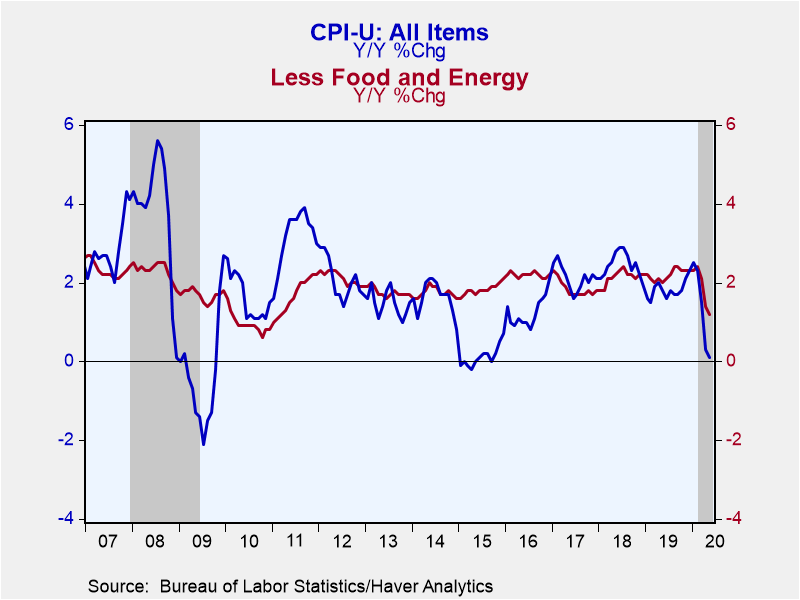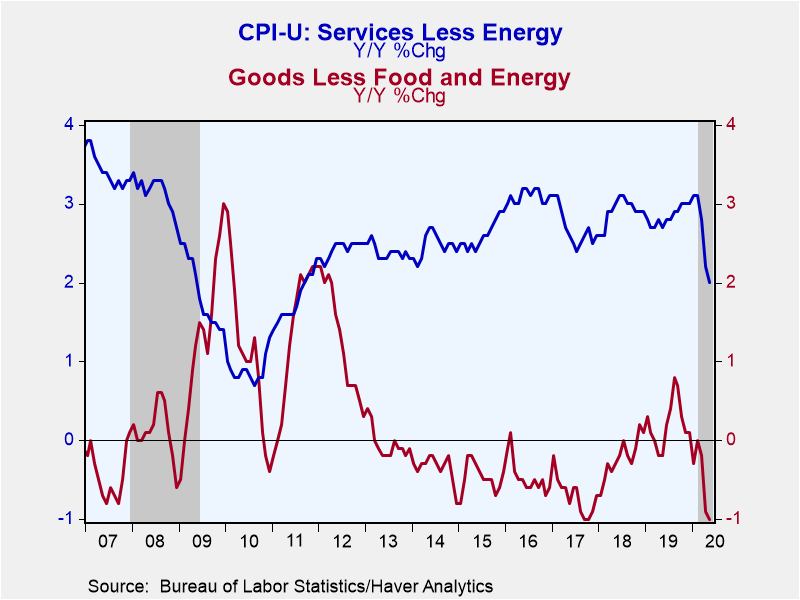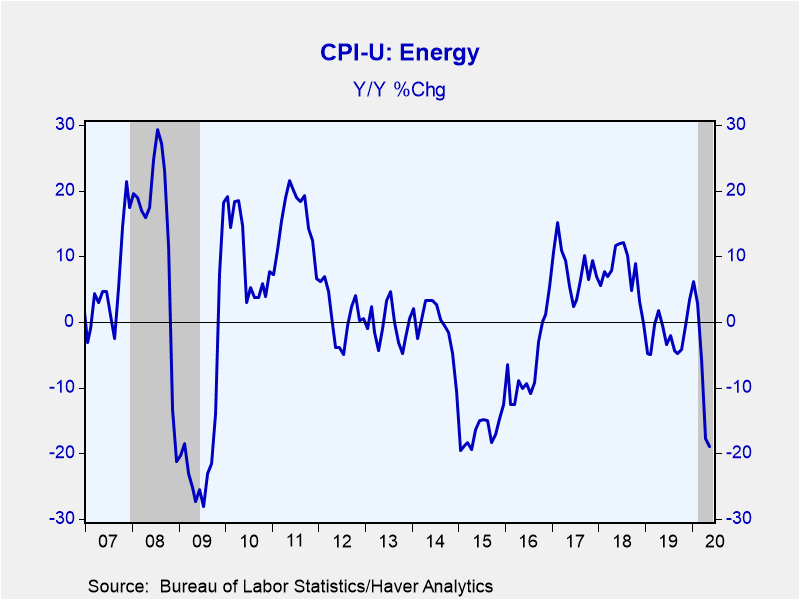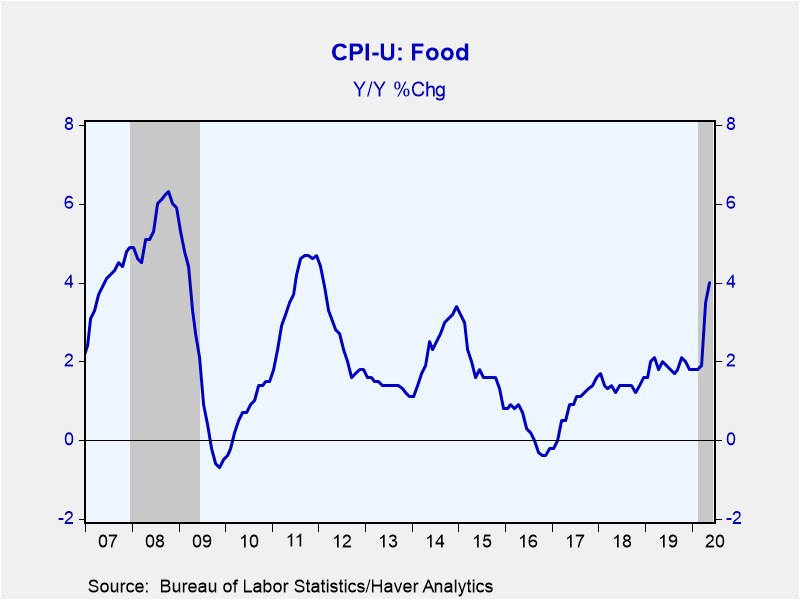 Global| Jun 10 2020
Global| Jun 10 2020U.S. Consumer Price Index & Core Prices Ease in May
by:Tom Moeller
|in:Economy in Brief
Summary
• Pricing power is weighed down by economic weakness due to coronavirus shutdowns. • Food prices continue to strengthen. • Energy prices weaken further. The record decline in overall activity this quarter is weighing on pricing power. [...]
• Pricing power is weighed down by economic weakness due to coronavirus shutdowns.
• Food prices continue to strengthen.
• Energy prices weaken further.
The record decline in overall activity this quarter is weighing on pricing power. The CPI slipped 0.1% (+0.1%) during May following a 0.8% April drop which was the largest decline since late-2008. It was the third consecutive month of decline. The easing compared to expectations for no change in the Action Economics Forecast Survey. The CPI excluding food & energy also eased 0.1% (+1.2% y/y) last month after weakening 0.4% in April. The decline also was the third consecutive monthly fall. It compared to expectations for no change.
Despite the decline in prices overall, food prices increased 0.7% (4.0% y/y) led by a 1.0% strengthening (4.8% y/y) of prices for food at-home consumption. It followed a 2.6% upward spike during April. Meat, poultry & fish prices surged 4.3% (9.8% y/y) after a 3.6% gain. Egg prices eased, however, by 4.8% (+13.5% y/y) following a 16.1% jump. Cereal & cereal product prices strengthened 1.5% (3.2% y/y), about as they did in April. Dairy & dairy product prices increased 1.0% (5.7% y/y) after rising 1.5%. Fruit & vegetable prices rose 0.5% (1.5% y/y) after strengthening 1.5%. Offsetting the gains was a 0.8% decline (+2.3% y/y) in bakery product prices which came after a 3.1% jump. Nonalcoholic beverage prices held steady (4.1% y/y) after rising 2.9%. Prices for food away from home rose 0.4% (2.9% y/y) after edging 0.1% higher in April.
A decline in energy product prices offset these increases with a 1.8% drop (-18.9% y/y), the fifth consecutive monthly decline. Gasoline prices weakened 3.5% (-33.8% y/y) after double-digit declines during the prior two months. Fuel oil prices fell 6.3% (-37.5% y/y) to the lowest level in nearly 15 years. Natural gas prices rose 0.8% (-0.3% y/y) following a modest increase, while the cost of electricity fell 0.8% (-0.2% y/y) following a 0.1% uptick.
Goods prices excluding food & energy weakened 0.2% last month (-1.0% y/y), the third straight month of decline. The shortfall was led by a 2.3% weakening (-7.9% y/y) in apparel prices on the heels of two straight monthly declines. Recreation goods prices held steady (-2.1% y/y) after falling for three consecutive months and prices for medical care goods improved 0.1% (0.8% y/y), the first increase this year. New vehicle prices rose 0.3% (-0.3% y/y) but used car & truck prices fell 0.4% (-0.4% y/y) for a second straight month. Appliance prices held steady (1.2% y/y) after surging 1.1% while household furnishings prices improved 0.6% (0.9% y/y) for a second straight month. Prices for education & communication goods eased 0.1% (-3.5% y/y).
Services prices eased in May (2.0% y/y), down for the third straight month. It was paced by a 3.8% drop (-19.8% y/y) in the cost of public transportation. Recreation services prices strengthened a record 1.3% (4.3% y/y). Medical care service prices improved 0.6% (5.9% y/y) after two straight 0.5% gains. Education & tuition prices edged 0.1% higher (2.0% y/y) for a fourth straight month. Shelter costs rose 0.2% (2.5% y/y) following two months of stability but the owners' equivalent rent of primary residences gained 0.3% (3.1% y/y).
The Consumer Price Index data can be found in Haver's USECON database with additional detail in CPIDATA. The Action Economics survey figure is in the AS1REPNA database.
| Consumer Price Index, All Urban Consumers (% chg) | May | Apr | Mar | May Y/Y | 2019 | 2018 | 2017 |
|---|---|---|---|---|---|---|---|
| Total | -0.1 | -0.8 | -0.4 | 0.1 | 1.8 | 2.4 | 2.1 |
| Total less Food & Energy | -0.1 | -0.4 | -0.1 | 1.2 | 2.2 | 2.1 | 1.8 |
| Goods less Food & Energy | -0.2 | -0.7 | -0.3 | -1.0 | 0.2 | -0.2 | -0.7 |
| Services less Energy | -0.0 | -0.4 | -0.0 | 2.0 | 2.8 | 2.9 | 2.7 |
| Food | 0.7 | 1.5 | 0.3 | 4.0 | 1.9 | 1.4 | 0.9 |
| Energy | -1.8 | -10.1 | -5.8 | -18.9 | -2.1 | 7.5 | 7.9 |
Tom Moeller
AuthorMore in Author Profile »Prior to joining Haver Analytics in 2000, Mr. Moeller worked as the Economist at Chancellor Capital Management from 1985 to 1999. There, he developed comprehensive economic forecasts and interpreted economic data for equity and fixed income portfolio managers. Also at Chancellor, Mr. Moeller worked as an equity analyst and was responsible for researching and rating companies in the economically sensitive automobile and housing industries for investment in Chancellor’s equity portfolio. Prior to joining Chancellor, Mr. Moeller was an Economist at Citibank from 1979 to 1984. He also analyzed pricing behavior in the metals industry for the Council on Wage and Price Stability in Washington, D.C. In 1999, Mr. Moeller received the award for most accurate forecast from the Forecasters' Club of New York. From 1990 to 1992 he was President of the New York Association for Business Economists. Mr. Moeller earned an M.B.A. in Finance from Fordham University, where he graduated in 1987. He holds a Bachelor of Arts in Economics from George Washington University.










